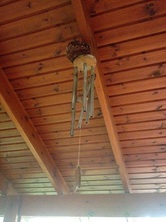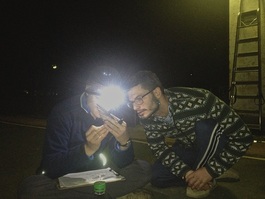 Why are you nesting there?
Why are you nesting there?  Tal banding for the first time
Tal banding for the first time To read more about our trip check out Joey Hubbard’s blog.
 Why are you nesting there? Why are you nesting there? לבלוע, that is Hebrew for swallow (said snu-neet). Joey and I have gotten quite good at saying this word to explain to people just what exactly we are doing on their front porches staring up at the ceiling with strange yellow poles in our hands. Barn swallows in the holy land don’t actually live in barns, they live on people’s houses, usually right above the front door where there is as much chaos as possible. Israeli barn swallows are sabra as well it seems. People seem quite surprised that we have come all the way to Israel to study these common and rather pesky birds. We try and explain to them that the Israeli barn swallows are special (oh and to please, please not to knock the nest down, we know they poop everywhere, but they are really special!). All and all, people have been amazingly tolerant of us. So why exactly are we here, other then eating amazing hummus everyday? Well- to sum it up: We are here trying to figure out how new species form. Barn swallows around the world are in the middle of becoming new species. One of the reasons is that females are using different traits to pick their mates in different populations. We are in Israel studying one of these populations trying to figure out why females find certain male traits attractive. This is part of a comparative study between the Czech Republic, Colorado and Israel. In the Czech Republic, females like males with sexy long tail streamers, while in Colorado females don’t care about a male’s streamers, instead they like dark breast feathers. Israel is special because females here are attracted to males with both long streamers and dark breast feathers. My PhD research is looking at how parasites fit into all of this sexual attraction (steamy right?). These male traits, other then making males look rugged and handsome, also tell the female something useful. This often has to do with parasites. So far, I have found that long tailed males in the Czech Republic are infected with fewer lice and previous studies suggest that they have parasite resistant genes. Those attractive dark males in Colorado have nests with fewer blood-sucking mites in them (pretty good reason to hook up with them instead of the other males). We are in Israel trying to figure out what tail and color together are signaling to females here. To do this research, we are spending 6 weeks in northern Israel by the Sea of Galilee, which we discovered is not actually a sea but a fresh water lake, which makes it even more impressive that Jesus supposedly walked on it. We are living in Ami’ad kibbutz, which is home to the Ami’ad water systems factory, a plantation of avocado, lemon, lychee, and olive trees, 42 barn swallows, about 100 stray cats, and 432 very friendly people. Life at Ami’ad has changed in many ways since it was founded in 1946 by 28 young Plmach soldiers, most of whom had escaped from Europe during or after world war two. It was founded on the principles of socialism and Zionism. It has been fascinating for Joey and I to meet and talk to people our age that grew up in Ami’ad when it was still a fully social kibbutz. They told us how everything was communal, from the houses to the clothes on people’s backs. The kids grew up without knowing what money was and were raised in children’s houses instead of in homes with their parents. There are no roads except around the outside of the kibbutz because no one had a car. It is laid out with walking paths, green spaces and trees. Ami’ad is different now of course, the communal life style is gone but much of the community spirit seems to have remained. People still don’t officially own the houses they live in, but that will change soon. There is a dining hall where people gather for lunch and community center with classes. The kids still go to community kindergarten on the kibbutz (school/daycare for ages 3 months to 7 years old). Neighbors still gossip over coffee and worry whether those American girls who have moved in really have everything they need. The young people who have moved back to Ami’ad after the army and school and travel, gather at the pub that opens on the weekends to share stories about what it use be like growing up on a kibbutz.  Tal banding for the first time Tal banding for the first time Our fieldwork extends beyond Ami’ad to a small village called Kahal (where our collaborator and amazing host Yoni Vortman lives) and another kibbutz called Huqoq which is not far as the crow flies but takes 20 minutes to drive to because there is a canyon in the way. We have hit the ground running and have found 46 barn swallow nests to date, ten of which have eggs. We have caught 21 adult barn swallows and are training two field assistants who will continue monitoring nests after we return to the states. We recently took our Ami’ad field assistant, Tal, night banding with us for the first time. He is game, but after watching us measure and collect samples from a pair of birds, he told us he thought everything we did was very weird. I guess that is not an unfair assessment. In other news, we learned that we could glean avocados off the ground in the orchard just up the road from our little apartment and ever since have been eating fresh avocados for every meal. Some days, joey and I consume up to 6 avocados between the two of us. More soon to come on our adventures to the mountain city of Tzfat and the 4,000 year old port of Akko. To read more about our trip check out Joey Hubbard’s blog.
3 Comments
Ruth Hund
2/13/2015 11:40:18 am
Wow! Who would have thought swallows were so romantic! Keep up the posts. I love hearing about your travel and research!
Reply
lizz
2/17/2015 04:34:12 am
Amanda, I just love this! So interesting. I wish I was with you....I'd swim in the Dead Sea, hike on the trails, eat fabulous fresh food...so since I can't be there, please soak it all in and come back with stories!
Reply
Amir
8/16/2022 09:48:40 am
We live in Korazim and I’ve been watching the swallows sho have built a mud nest on the ceiling of our porch. Seems like the parents aren’t thrilled about letting their kids back into the nest. Sort of do it grudgingly. Is this a thing? Did they build the nest small enough to make it uncomfortable for the kids after a while? Giving me some ideas for my own situation. Please email me to let me know. Thanks!
Reply
Leave a Reply. |
To Follow a SwallowUpdates from the field, at home and around the world. Archives
June 2018
Categories |